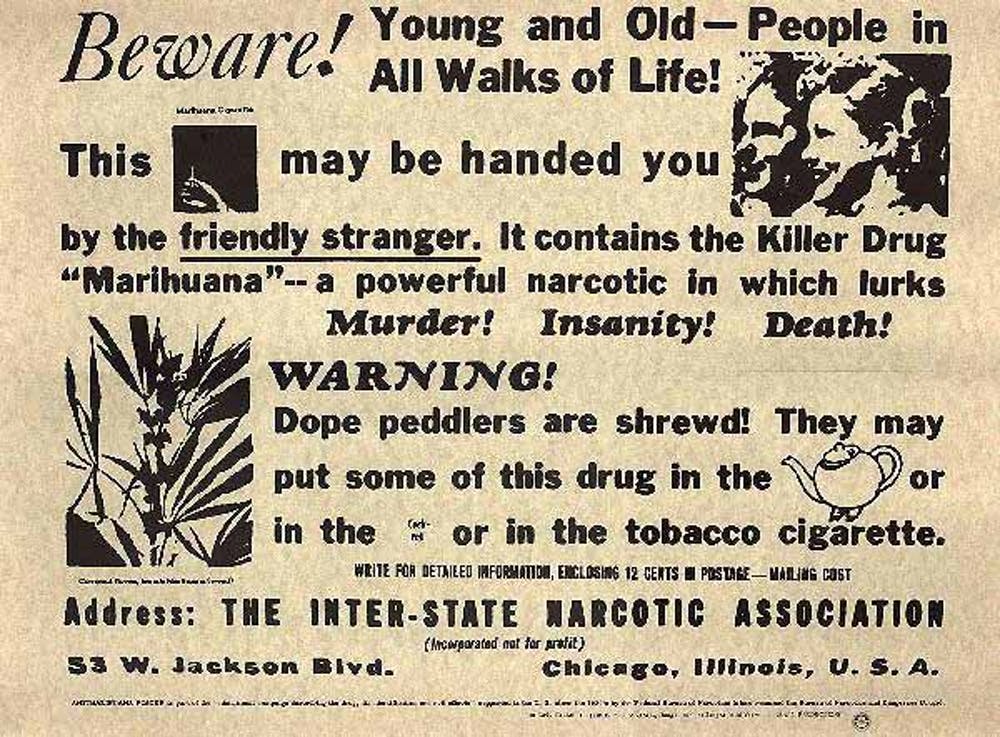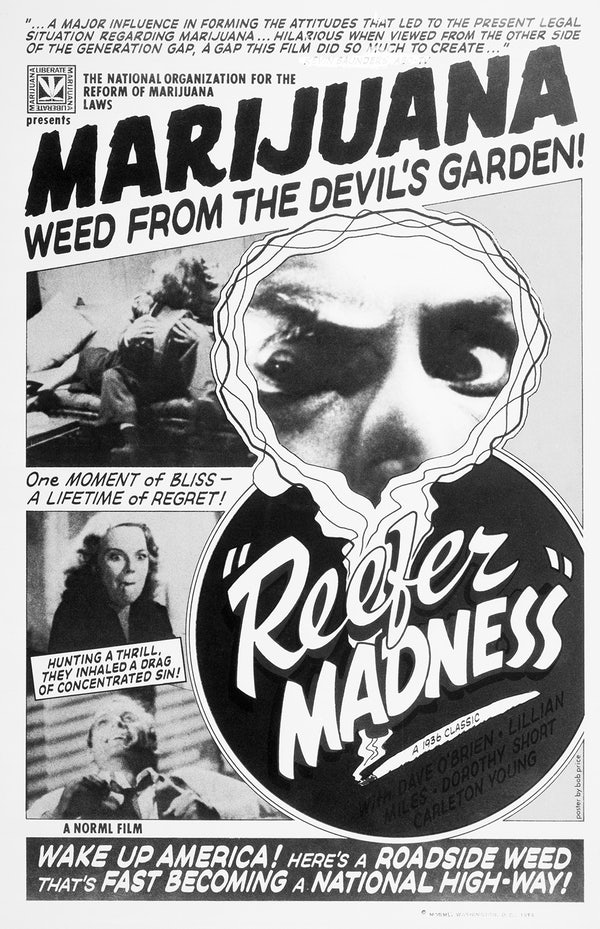The greatest mistakes in history: Hemp prohibition.
Nowadays the questions of marijuana legalization or decriminalization are actively revised in the world. Somewhere positive decisions have already been made, but somewhere they have yet to be made. A little more than 80 years have passed since the beginning of the war against hemp, but the history of this struggle still leaves questions. And the main question is: Was it all so unequivocally in the history of the confrontation between hemp and the law, and do the lobbyists stick out from the unbearable burden of the prohibitions of that time?
We are not going to talk about how hemp have been used since ancient times, when the last freezing mammoth was convulsed in the vast expanses of Siberia. Neither will we compare it with alcohol, nor will we draw conclusions. In the context of this topic, the history of the prohibition, and especially its real reasons will be much more interesting to us!
Cannabis was included into the list of US medical products, and was actively used in medicine from 1850 to 1942. Its extract was prescribed for migraines, asthma, rheumatism, loss of appetite, as an anesthetic, for nausea, physical exhaustion, and so on. Cannabis extract was sold at every pharmacy during that period. It would seem that nothing foreshadowed changes, when suddenly something went wrong: on a warm August day in 1937, the US Congress passed a law on marijuana tax.
According to that law, it was forbidden to store and transport hemp throughout the USA. The amount of tax (excise tax) for hemp producers, as well as for medical and research institutions was so exorbitant, and the punishment for any deviation from a legal act became so severe that this meant an unstated prohibition.
Despite the widespread and mass protests of physicians, the voice of the law was unshakable, and soon the use of cannabis in the medicine composition declined, and then completely stopped.

The main apologist for the prohibition of any use of cannabis – from agricultural to medical – was the racist Harry Anslinger, a very peculiar personality. According to him, “The main reason for the need to prohibit cannabis lies in its disastrous effect on degenerative races”, as well as: “Marijuana allows black people to imagine themselves as equal with white people”. Besides, Anslinger demanded to prohibit jazz and swing because this had been “satanic music”. His agents reported: “Many jazzmen influenced by marijuana think that they play great, though in reality they play terrible.” The Federal Bureau of Narcotics came to the conclusion that marijuana dramatically slows down the perception of time, and this was the reason why jazz music sounds so bizarre. Thus, Anslinger considered jazz the evidence that marijuana had been driving people crazy.
Such speakers seem ridiculous nowadays, but they have created the basis of the legislation to which we obey to this day!
Media magnate William Randolph Herest was an assistant to Anslinger. He owned a newspaper empire and used it to promote articles that showed relation between crime and use of cannabis. Since 1933, these two launched the most powerful in the history information campaign of demonizing cannabis in the media. They started their actions with truly fanatical enthusiasm. Besides summarizing the influence of marijuana on committing serious crimes under the necessary data, these two reached the point of utter absurdity, claiming that hemp had been a Russian weapon for America destruction.
Dozens of chilling stories about cruel murders and atrocities taking place allegedly under the influence of marijuana came down daily on the unsuspecting readers from the pages of newspapers. For example, in the fall of 1933, in the small town of Tampa in Florida, someone Victor Licata brutally killed his family with an ax. The tragedy could remain only in the memory of the town and not get wide publicity if it were not for Anlinger’s campaign against marijuana. The director of the government department “found out” that Licata had used marijuana, and declared that the plant was the cause of the massacre. After the law adoption, it turned out that Licata suffered from schizophrenia, and marijuana had no bearing on the subject of the crime, however, that information did not reach the great masses of consumers.

This is just one story in a series of more than 2,000 violent crimes that Anlinger managed to completely blame the use of marijuana during his activities. The impact of marijuana on committing crimes was refuted in all the cases described, and several crimes were made up by Anslinger himself.
Thus, the anti-drug propaganda machine which launched its flywheel back in the 1930s in the United States, gave rise to the stereotypes, prejudices and fears prevailing today that have not lost their charming power over our minds till now.
Was Anslinger really a conservative fanatic, and did he believe in that bunkum he spoke? Definitely not! This will be told us by the abundance of facts clearly confirming how rudely he manipulated the available information about cannabis. Moreover, it is worth mentioning that Anslinger’s opinion on cannabis had been of a sharply opposite nature until the 1930s: He pronounced that cannabis had done no harm to people, and there hadn’t been more absurd statement than the fact that using marijuana contributes to the violence growth.
What had become the starting point for such a radical change in the Anslinger’s worldview?
William Hurst, who was the active transmitter of Anslinger’s lie owned, in addition to the newspaper business, a huge amount of land with a forest. He used the wood to make paper, and the paper from wood needed to be bleached. Meanwhile, the first industrial cannabis decorticator was launched in the US market.

Hemp decortication created a new low-cost replacement of pulp for paper production. Alternative raw materials could be reduced, and, perhaps, completely knocked the wood out of the industry as the main element of the paper industry.
Thus, initially Anslinger who initially had a positive attitude towards cannabis, after meeting Hearst, suddenly announced a holy crusade to marijuana. Is it coincidence? Unlikely! Hurst, by the way, was not the only interested person in this story.
In the 1930s, DuPont company intensively developed nylon fibres and industrial paper bleach. Suddenly, the company joined William Hearst who needed chemicals to bleach paper. By the mid-1930s, DuPont was already producing synthetic fabrics and bleaches for paper. But hemp prevented the promotion of synthetic products on world markets, as stated above. At that time, paper, clothing, footwear, ropes, food, cosmetics, medical preparations, and products for the pet business were made of it – more than 25 thousand items of products in all. Its planting area was millions of hectares around the world.
In 1935, DuPont chemists invented nylon which became a powerful competitor to hemp thread. Hemp has long annoyed representatives of the company, just because the paper produced from it, unlike that made from wood, did not require bleaching. So, the reagents produced by the chemical giant were not needed. And the chemists of the company in alliance with Hurst launched a broad offensive against the most profitable crop.
From that time, in the Hirst newspapers, and later in all the other newspapers, hemp was named only in Mexican style – marijuana. And they no longer called it as an agricultural crop, but as a harmful drug. As it is today considered by many researchers, it was Anslinger who was the conductor of the business interests of Hurst and Dupont.
However, ‘yellow’ newspaper is not enough to adopt such a serious law, so Anslinger, after all, had to turn to scientists. However, he did it in a somewhat peculiar way: He addressed 30 scientists with a question about the dangers of cannabinoids. 29 of them denied harm, and only one of them agreed with Harry. The point of view of that scientist became the “voice of science” at the Congressional testimony in the US.
However, this was only an intermediate finish for Anslinger. Having put any use of cannabis in the ‘Out of the Law’ position in the USA, he launched massive propaganda in the world media with the same fanaticism, and the world media largely contributed to the inclusion of marijuana in the United Nations Single Convention on Narcotic Drugs. Apparently, the Convention was to be the result of his life. In 1962, Anslinger retired when he reached the limit for civil officers at the age of 70. Only ten years after his resignation, everything began to return to normal, and the laws regarding the use of marijuana began to gradually soften.
Nowadays the reverse process to legalize marijuana has been launched, which is marching victoriously across the planet. The exhaustible path to the full legalization of marijuana has already been passed by two countries: Uruguay (2013) and Canada (2018), as well as partly by the Netherlands; in 26 states of the USA, marijuana is permitted for recreational and medical purposes or only for medical purposes. Medical use of marijuana is permitted in Israel, Denmark, Australia, Macedonia, Croatia, Romania, New Zealand, Puerto Rico, Turkey and a number of other countries. In some countries, the use of marijuana is attributed to administrative offence: Spain, Portugal, the Netherlands, Belgium, UK.
The process is very slow and difficult because marijuana acts as a competitor to, for example, painkillers and somnifacients. This is a huge market for pharmacology, and they would not want at all to lose profits, and therefore will resist the natural anesthetic with last bit of strength. Marijuana does not pose a threat to the general public. Marijuana is a threat to oil companies, alcohol, tobacco industries and a large number of chemical corporations. Various large enterprises with a large amount of money and influence will oppose its victorious procession in every possible way, inventing new and new horror stories for society. The truth is that if hemp was used in its wide range of commercial products, it would lead not only to medical, but also to industrial resonance! And… to the death of a huge number of corporations, which, if it is legalized, will be left out of world business.
However, nothing lasts forever. Today, only a faded shadow has remained from the times of anti-hemp terror, and that is inexorably melting away, since Aslinger’s figure is moving further and further away from the light source of enlightenment, and the pathetic attempts of its supporters and followers no longer have past influence on the minds of the people, and therefore they are inexorable will blow away from Europe with the coming wind of change!

